
Web Developers
INTRODUCTION: ENTERPRISE WEARABLES MARKET SET TO BOOM
Wearable technology, such as the Apple Watch, the Fitbit fitness band and Google Glass, is popularly seen as adding an extra layer of convenience in consumers’ lives. But there is a whole world of wearable business use in which this technology improves productivity, adds to employee safety or improves customer service. In this report we look at the use of wearables in industry. This report complements our recently published major overview, The Wearables Report 2016: Reviewing a Fast-Changing Market. Wearables are technology worn on the body, often divided into three categories based on the part of the body on which they are worn: head (e.g., smart glasses and helmets), body (e.g., clothing and body cameras) and wrist (e.g., smart watches and activity trackers). This report focuses on the following themes:- The significant growth expected for business, or “enterprise,” wearables. The enterprise wearables market is expected to outpace total wearables market growth.
- Types of firms that have been early adopters of wearable technology. Companies in field services and manufacturing are among the early adopters that use enterprise wearables, and usage across industries is growing.
- The privacy and security concerns of users or potential users. Although many consumers are willing to use wearable technology provided by their company and believe it could boost productivity, many have concerns it might invade their privacy.
- The different functions of enterprise wearables. Depending on the industry, wearables can be used to scan and track products, as a fatigue management tool, for hands-free audio-and video-recording, and as part of corporate wellness programs.
ENTERPRISE WEARABLES MARKET GROWING FASTER THAN TOTAL WEARABLES MARKET
First, we take a look at the scale and growth prospects of the overall wearables market and the industrial wearables segment. Market-measurement firm Gartner estimates the number of wearables shipped worldwide is forecast to grow from 232 million in 2015 to 323 million by 2017. This represents a CAGR of 17.9% and includes consumer wearables and enterprise wearables. Starting from a low base, the enterprise wearables segment is expected to grow faster than the total wearables market, with a CAGR in unit sales of 75.1% between 2015 and 2021. Market-intelligence firm Tractica estimates global revenue for enterprise wearable devices will grow from $198.45 million in 2015 to $12.68 billion in 2021. During the same period, Tractica expects enterprise wearables shipments to grow from 2.3 million units to 66.4 million. [caption id="attachment_90589" align="aligncenter" width="381"]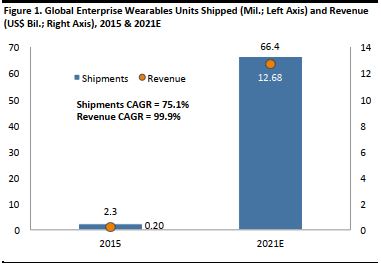 Source: Tractica/Fung Global Retail & Technology[/caption]
Source: Tractica/Fung Global Retail & Technology[/caption]
Business Applications That Drive Wearable Technology
According to technology market research company Beecham Research, enterprise is the biggest platform for augmented reality (AR) and wearable device applications. The company identified healthcare, logistics, manufacturing and retail as some of the most dynamic markets for wearables. Below, we list by sector some functions and products for enterprise wearables. [caption id="attachment_90592" align="aligncenter" width="550"]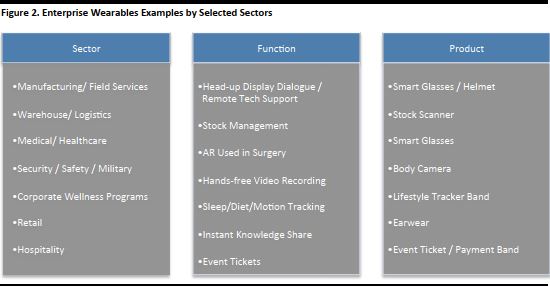 Source: Beecham Research/Tractica/Fung Global Retail & Technology[/caption]
Professional services company PwC said wearable technology already impacts companies in manufacturing and field service industries. Workers who deal with machines, and manage the installation and repair of systems or equipment, often work in remote locations and typically need to stop what they are doing in order to get instructions or guidance from supervisors. When they use wearables, workers’ concentration and progress is undisturbed.
Source: Beecham Research/Tractica/Fung Global Retail & Technology[/caption]
Professional services company PwC said wearable technology already impacts companies in manufacturing and field service industries. Workers who deal with machines, and manage the installation and repair of systems or equipment, often work in remote locations and typically need to stop what they are doing in order to get instructions or guidance from supervisors. When they use wearables, workers’ concentration and progress is undisturbed.
Smart Watches Most Used Enterprise Wearables
We now look at which type of wearables are most commonly used in business environments. First, we will take a look at industrial wearables, including devices used in manufacturing and field services. Fully 93% of industrial Information Technology (IT) and business decision-makers in the US evaluated or used wearables in June 2015, according to a survey by smart device software provider APX Labs. Many of these decision-makers believe wearable enterprise devices will be commonly used in the coming years. Indeed, fully 87% of industrial IT decision-makers believe wearable technology will have a significant impact across their industry by 2020. APX Labs noted smart watches and activity trackers were the most commonly used industrial enterprise wearables in 2015, but the use of smart glasses in work environments is growing the fastest. Google is set to re-launch its Google Glass product with a focus on business use, which is likely to bolster enterprise use of smart glasses. [caption id="attachment_90617" align="aligncenter" width="377"]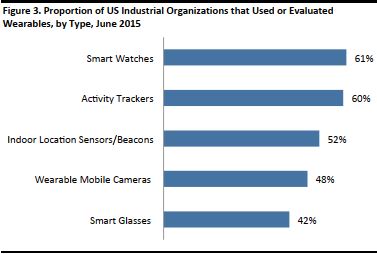 Survey of 201 US industrial enterprise sector decision-makers.
Survey of 201 US industrial enterprise sector decision-makers.Source: APX Labs[/caption] The findings charted in Figure 3 may not reflect the enterprise wearables trends across different sectors, because industrial manufacturing and field service industries likely lead other sectors in implementing wearable technologies. According to a survey of US business professionals by cloud services company Salesforce, among, “early adopters,” those who were at the time using, piloting or planning to implement wearable technology in the enterprise, nearly half expect smart watches to have the biggest impact on their enterprise. [caption id="attachment_90624" align="aligncenter" width="377"]
 Online survey of 500 full-time business professionals in the US, who were using or planning to implement wearable technology.
Online survey of 500 full-time business professionals in the US, who were using or planning to implement wearable technology.Source: Salesforce[/caption] Data from other firms confirm the growing scale of wearables business use. According to market-measurement firm Gartner, growth in fitness wearables is partly driven by wellness programs in the US. The company also estimates the enterprise use for head-mounted displays (HMD) will grow in the coming years, with a forecast 26% of HMDs in 2018 designed for enterprise use. Gartner notes enterprise HMDs originated as expensive military projects, but the market is now emerging and HMDs are used across many industries, and new products have come to market such as Microsoft HoloLens. [caption id="attachment_90627" align="aligncenter" width="410"]
 Source: Microsoft[/caption]
Source: Microsoft[/caption]
INDUSTRY CASE STUDIES
Below, we explore case studies of wearable technologies designed especially for business use. Commercial prices were not available for the majority of wearables; often the price per unit depends on who buys the product and how many units they buy. A theme that runs through a number of the case studies below is industrial safety. Several devices featured focus on the issue of fatigue in the workplace. Caterpillar, a manufacturer of construction and mining equipment, worked with Fatigue Science to develop a fatigue risk management system called Cat Smartband. Management can monitor employees’ sleep and wake periods with the system and, if their effectiveness score is low, the employee is considered to be fatigue impaired. Cat Smartband is part of Caterpillar’s comprehensive fatigue risk management solution.
Caterpillar, a manufacturer of construction and mining equipment, worked with Fatigue Science to develop a fatigue risk management system called Cat Smartband. Management can monitor employees’ sleep and wake periods with the system and, if their effectiveness score is low, the employee is considered to be fatigue impaired. Cat Smartband is part of Caterpillar’s comprehensive fatigue risk management solution.
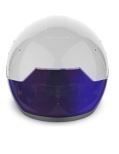 Daqri Smart Helmet is an augmented reality device which can be used for data visualization and control connections that link to critical real-time information. Clients for the smart helmet include companies from the manufacturing, automation, transportation, utilities, and oil and gas sectors. The company has partnered with companies such as Intel, Autodesk and Topcon to develop augmented reality hardware and software solutions.
Daqri Smart Helmet is an augmented reality device which can be used for data visualization and control connections that link to critical real-time information. Clients for the smart helmet include companies from the manufacturing, automation, transportation, utilities, and oil and gas sectors. The company has partnered with companies such as Intel, Autodesk and Topcon to develop augmented reality hardware and software solutions.
 UK-based smart-wearable company Fhoss Technology manufactures and supplies light emitting work safety-wear. Their clients include companies from the railway, construction and oil industries. According to the company, users of Fhoss smart wearable technology may be entitled to reduced insurance premiums.
UK-based smart-wearable company Fhoss Technology manufactures and supplies light emitting work safety-wear. Their clients include companies from the railway, construction and oil industries. According to the company, users of Fhoss smart wearable technology may be entitled to reduced insurance premiums.
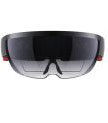 Microsoft HoloLens is a mixed reality tool that combines augmented reality and virtual reality. Users can blend 3D holographic content into their physical world with the HoloLens head-mounted display. As of August 11, 2016, Microsoft HoloLens Development Edition was available to developers only, for $3,000.
Microsoft HoloLens is a mixed reality tool that combines augmented reality and virtual reality. Users can blend 3D holographic content into their physical world with the HoloLens head-mounted display. As of August 11, 2016, Microsoft HoloLens Development Edition was available to developers only, for $3,000.
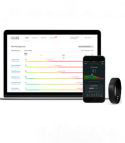 Human performance improvement company Fatigue Science’s Readiband is a tool to track and prevent fatigue in the workplace. Readiband uses the SAFTE (Sleep, Activity, Fatigue, and Task Effectiveness) model, which was developed by the US Army and validated by the US Department of Transportation. Readiband is used by professional sports teams and in construction, mining, transport and other heavy industries.
Human performance improvement company Fatigue Science’s Readiband is a tool to track and prevent fatigue in the workplace. Readiband uses the SAFTE (Sleep, Activity, Fatigue, and Task Effectiveness) model, which was developed by the US Army and validated by the US Department of Transportation. Readiband is used by professional sports teams and in construction, mining, transport and other heavy industries.
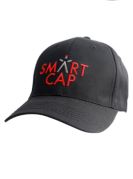 Developed to monitor and detect drivers’ fatigue in working environments, SmartCap, is produced by an Australian smart-wear company The headwear cap is fitted with a sophisticated sensor that can read brainwaves to determine an individual’s fatigue (alertness/drowsiness) level. SmartCap is used mainly in mining and trucking sectors, but the company also provides smart headwear for commercial use.
Developed to monitor and detect drivers’ fatigue in working environments, SmartCap, is produced by an Australian smart-wear company The headwear cap is fitted with a sophisticated sensor that can read brainwaves to determine an individual’s fatigue (alertness/drowsiness) level. SmartCap is used mainly in mining and trucking sectors, but the company also provides smart headwear for commercial use.
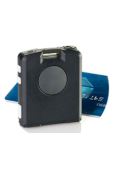 US-based Theatro’s voice-controlled enterprise wearables allow hands-free communication among retail and warehouse employees. With the voice-controlled device, employees have real-time access to inventory via in-store wi-fi, while they are they are serving customers. The small, 1.5 ounce wearable also gives management access to analytics on employee performance.
US-based Theatro’s voice-controlled enterprise wearables allow hands-free communication among retail and warehouse employees. With the voice-controlled device, employees have real-time access to inventory via in-store wi-fi, while they are they are serving customers. The small, 1.5 ounce wearable also gives management access to analytics on employee performance.
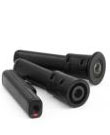 Genetec’s Vidcie body wearable cameras deliver on-demand, hands-free video. Vidcie cameras are used by security teams when planned or unexpected events go beyond the sight of fixed surveillance perimeters. The company’s clients include airports, manufacturing sites, sports stadiums and retailers.
Genetec’s Vidcie body wearable cameras deliver on-demand, hands-free video. Vidcie cameras are used by security teams when planned or unexpected events go beyond the sight of fixed surveillance perimeters. The company’s clients include airports, manufacturing sites, sports stadiums and retailers.
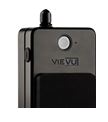 Vievu body-worn cameras, created by law enforcement company The Safariland Group, allows users to record hands-free video and audio. Vievu products are built for law enforcement and military use. The company’s clients include police departments and other safety, military and professional authorities.
Vievu body-worn cameras, created by law enforcement company The Safariland Group, allows users to record hands-free video and audio. Vievu products are built for law enforcement and military use. The company’s clients include police departments and other safety, military and professional authorities.
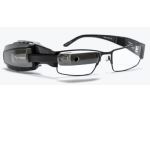 Vuzix smart glasses are a wearable computer with a monocular display and recording features. The glasses can plan routes with AR, provide access to online data and link to the user’s phone. Clients include companies in warehouse logistics, field services and manufacturing. According to the company, Vuzix M100 glasses are the world’s first commercially available smart glasses, with prices starting from $999.99.
Vuzix smart glasses are a wearable computer with a monocular display and recording features. The glasses can plan routes with AR, provide access to online data and link to the user’s phone. Clients include companies in warehouse logistics, field services and manufacturing. According to the company, Vuzix M100 glasses are the world’s first commercially available smart glasses, with prices starting from $999.99.
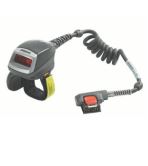 Zebra Technologies’ products and services include printers, radio-frequency identification (RFID) solutions, mobile computers, and scanners such as hands-free ring scanners. Paired with a wearable mobile computer on the employee’s arm, the device can zoom in on barcodes from as far away as 15 feet. The ring scanner assists employees in warehouses, distribution centers and retail stores. The company is headquartered in the US.
Zebra Technologies’ products and services include printers, radio-frequency identification (RFID) solutions, mobile computers, and scanners such as hands-free ring scanners. Paired with a wearable mobile computer on the employee’s arm, the device can zoom in on barcodes from as far away as 15 feet. The ring scanner assists employees in warehouses, distribution centers and retail stores. The company is headquartered in the US.
Google’s Enterprise Wearable Projects
Google is turning its attention to enterprise wearables through its Google Glass product and joint venture with Levi’s. According to Tractica, companies such as General Motors, BMW, DHL, Boeing and Tesco tested Google Glasses for enterprise use. Google stopped selling its Google Glass eyewear in 2015, but insisted they will continue to develop additional versions of smart glasses. According to wearable technology website, Wareable, Google’s next smart glasses will be called “Google Glass Enterprise Edition,” and is targeted for enterprise use. As of July 2016, Google has not officially revealed details of the product and its functions. We think Google Glass stands a better chance in the enterprise space than in the consumer segment. Business users are more likely to need immediate access to the information these glasses provide; and we expect less concern over personal appearance when these kinds of glasses are used in a business environment. It is more acceptable to look a little “goofy” if there is a business reason behind it. In our overview, “The Wearables Report 2016: Reviewing a Fast-Changing Market,” we discussed Project Jacquard, a partnership between Google and Levi’s to develop connected clothing. In June 2016, Cintas Corporation announced a partnership with Project Jacquard to develop textile technology for enterprise use. Cintas supplies corporate products such as uniforms and safety apparel. The initial focus of the initiative will be on healthcare and safety applications.Corporate Wellness Programs and Wearable Technology
Wearable technology designed specifically for business is not the only case for enterprise use. A number of major employers are incorporating fitness wearables into their corporate wellness programs. British Petroleum (BP), is running a “BP Million Step Challenge” for its employees in the US, which encourages them to stay active with a complementary Fitbit activity tracker provided by the company. Participants in the wellness program earn points by meeting step goals tracked on their Fitbit device. In return, employees are eligible to receive contributions from BP to their Health Savings Accounts.
British Petroleum (BP), is running a “BP Million Step Challenge” for its employees in the US, which encourages them to stay active with a complementary Fitbit activity tracker provided by the company. Participants in the wellness program earn points by meeting step goals tracked on their Fitbit device. In return, employees are eligible to receive contributions from BP to their Health Savings Accounts.
 According to Fitbit, in 2015, 2014 and 2013, less than 10% of the company’s revenue were derived from their corporate wellness offerings. The company believes due to rising healthcare costs and employers’ growing interest in keeping employees active, more enterprises will implement their corporate wellness program. Fitbit’s Corporate Wellness program currently has more than 1,000 customers, such as Barclays, Boston College and Godaddy.com.
Fitbit said failure to comply with health-related laws and regulations, such as the Health Insurance Portability and Accountability Act of 1996 and the Health Information Technology for Economic and Clinical Health Act in the US, and EU Data Protection Directive, could adversely affect the firm’s financial condition, operating results and brand. Fitbit and its corporate wellness customers could be affected if there are changes in data collection laws and regulations, and as a result could be subject to legal liabilities, fines and negative publicity.
According to Fitbit, in 2015, 2014 and 2013, less than 10% of the company’s revenue were derived from their corporate wellness offerings. The company believes due to rising healthcare costs and employers’ growing interest in keeping employees active, more enterprises will implement their corporate wellness program. Fitbit’s Corporate Wellness program currently has more than 1,000 customers, such as Barclays, Boston College and Godaddy.com.
Fitbit said failure to comply with health-related laws and regulations, such as the Health Insurance Portability and Accountability Act of 1996 and the Health Information Technology for Economic and Clinical Health Act in the US, and EU Data Protection Directive, could adversely affect the firm’s financial condition, operating results and brand. Fitbit and its corporate wellness customers could be affected if there are changes in data collection laws and regulations, and as a result could be subject to legal liabilities, fines and negative publicity.
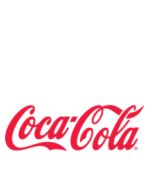 The Coca-Cola Company partnered with activity tracker, Misfit, in 2013 to offer exclusive red activity trackers as a premium giveaway product as part of My Coke Rewards loyalty program. The company also launched global well-being initiatives for its employees, including a wellness program in which employees are offered a Misfit activity tracker. Incentives for participants include discounts on future health insurance premiums.
The Coca-Cola Company partnered with activity tracker, Misfit, in 2013 to offer exclusive red activity trackers as a premium giveaway product as part of My Coke Rewards loyalty program. The company also launched global well-being initiatives for its employees, including a wellness program in which employees are offered a Misfit activity tracker. Incentives for participants include discounts on future health insurance premiums.
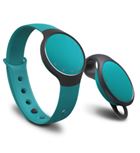 Wearable technology and smart-home product manufacturer Misfit has partnered with insurance and corporate well-being companies, including Oscar Insurance Corporation and Springday. Users are often encouraged to take part in wellness programs with financial incentives.
Wearable technology and smart-home product manufacturer Misfit has partnered with insurance and corporate well-being companies, including Oscar Insurance Corporation and Springday. Users are often encouraged to take part in wellness programs with financial incentives.
Enterprise App Use Cases for Wearables
Several wearables apps for business use have been developed, particularly for smart watches such as Apple Watch. For example, with the use of Microsoft PowerPoint Remote, users can control their presentations from their Apple Watch (pictured below). Companies such as Salesforce have also developed several business-use wearables apps for Apple Watch, including analytics and sales notification software applications. [caption id="attachment_90690" align="aligncenter" width="372"]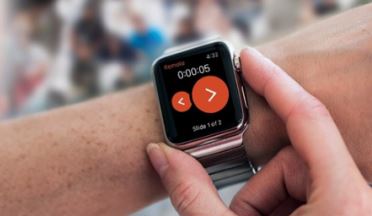 Source: Vivio[/caption]
Source: Vivio[/caption]
CONSUMERS STILL HAVE MIXED RESPONSES TO ENTERPRISE WEARABLES
Research suggests these kinds of technologies can provide a significant benefit to business. According to 2014 research led by Dr. Chris Brauer at Goldsmiths, University of London, productivity among employees in the UK and US who wore a wearable technology device at work increased by 8.5%, and their job satisfaction levels increased by 3.5%. Access to usually invisible data allowed participants to change their behavior. Dr. Bauer noted that “racing against oneself” helps improve performance. Although many people are interested in wearable technology, a large number have raised concerns over privacy and security. According to a PwC survey in 2014, fully 82% of US consumers surveyed said they were concerned wearable technology will invade their privacy. More positively, PwC’s survey found a very substantial 77% of US consumers surveyed thought wearables would make them more efficient or productive. Far fewer, although a still sizable 42%, thought their company should fund use of wearables. [caption id="attachment_90691" align="aligncenter" width="378"]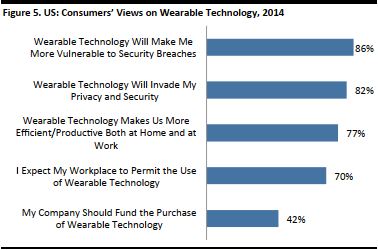 Survey of 1,000 consumers in the US.
Survey of 1,000 consumers in the US.Source: PwC[/caption] Research elsewhere has also shown widespread concern about privacy invasion by enterprise wearables. According to market research firm Vanson Bourne, nearly six out of ten respondents of 1,000 UK consumers interviewed were worried that wearable technology makes it easier for companies to spy on them. Additionally, 34% of respondents were worried about companies storing their personal information. The issue of privacy was also raised by Goldsmith’s Dr. Brauer, who highlighted how wearable technology can be seen as an intrusive surveillance tool rather than simply a means of improving productivity and performance.
Consumers Prefer an Institution To Pay for Expensive Wearables
Consumers are much more likely to adopt wearable technology if their employer pays for it. PwC conducted a survey that asked US consumers if they would be willing to spend $100 on different types of wearable technology, and asked them if they would be willing to adopt those technologies if an “institution” pays for them. The results show a minority of consumers would pay $100 for a smart watch, a fitness band or smart glasses—but a majority would use each of these types of wearables if an institution pays for it. PwC also found 85% of consumers surveyed would not be willing to buy a smart watch, fitness band or smart glasses at a price point of $300 or more. [caption id="attachment_90692" align="aligncenter" width="376"]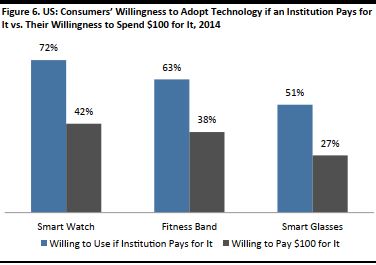 Survey of 1,000 consumers in the US.
Survey of 1,000 consumers in the US.Source: PwC[/caption] Consumers showed the greatest interest in buying a smart watch compared to a fitness band or smart glasses, whether the consumer or an employer pays for it. This reflects the overall greater popularity of wrist wearables, the most preferred type of wearables in the US and Europe, according to a 2014 survey by Forrester.